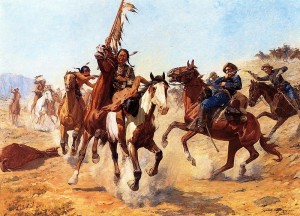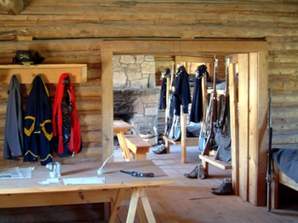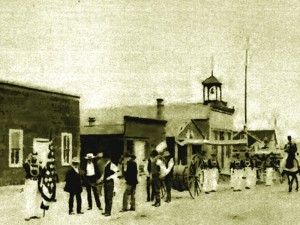caspar collins
 I don’t always think of myself as living in a historic area, although I should, because during the days of the Old West, at least, much history happened here. In fact, on this day, July 28, 1865, twenty year old Caspar Collins…a gutsy lieutenant from Dogwood Knob and Hillsboro, Ohio led 20 men to fight a battle against 1,000 to 3,000 Indians, just outside Platte Bridge Station, which was near Casper, Wyoming, where I live. The battle had been coming, and everyone knew it. The Lakota Sioux and the Cheyenne Indians had been attacking the United States Army for a couple of months now. The Indians had raided outposts and stagecoach stations over a wide area of Wyoming. On this day back in 1865, the Indians assembled their warriors and descended on Platte Bridge Station. The Platte River bridge was guarded by 120 men near the bridge, and another 28 soldiers guarded a wagon train a few miles away. The Indians killed 29 soldiers, while only losing 8 warriors in the raid.
I don’t always think of myself as living in a historic area, although I should, because during the days of the Old West, at least, much history happened here. In fact, on this day, July 28, 1865, twenty year old Caspar Collins…a gutsy lieutenant from Dogwood Knob and Hillsboro, Ohio led 20 men to fight a battle against 1,000 to 3,000 Indians, just outside Platte Bridge Station, which was near Casper, Wyoming, where I live. The battle had been coming, and everyone knew it. The Lakota Sioux and the Cheyenne Indians had been attacking the United States Army for a couple of months now. The Indians had raided outposts and stagecoach stations over a wide area of Wyoming. On this day back in 1865, the Indians assembled their warriors and descended on Platte Bridge Station. The Platte River bridge was guarded by 120 men near the bridge, and another 28 soldiers guarded a wagon train a few miles away. The Indians killed 29 soldiers, while only losing 8 warriors in the raid.
In reality, the Army was unprepared for this attack or the ones leading up to it. Colonel Thomas Moonlight had led a 500 Cavalry force out to seek out and punish the raiding Indians on May 26, 1865. He hung to minor Oglala leaders…Two Face and Black Foot. He left them hanging for days. I’m sure this infuriated the Indians. On June 3, the army began to worry that the 1,500 Lakota, mostly Brulé, and Arapaho who were living near Fort Laramie, might become hostile. So they decided to move them about 300 miles east to Fort Kearny in Nebraska. The Indians protested that Fort Kearny was in the territory of their traditional enemies, the Pawnee. The next day, near present day Morrill, Nebraska, most of the Indians refused to accompany the soldiers and  began crossing the North Platte River, assisted by Crazy Horse and a band of Oglalas on the other side. Attempting to stop them, Captain William D. Fouts and four soldiers were killed. Informed of the disaster, Moonlight departed Fort Laramie with 234 cavalry to pursue the Indians. He traveled so fast that many of his men had to turn back because their horses were spent. On June 17, near present day Harrison, Nebraska, the Lakota raided his horse herd and relieved him of most of his remaining horses. Moonlight and his men had to walk 60 miles back to Fort Laramie. He was severely criticized by his soldiers for being drunk and not setting a guard on his horses. On July 7, Moonlight was relieved of his command and mustered out of the army.
began crossing the North Platte River, assisted by Crazy Horse and a band of Oglalas on the other side. Attempting to stop them, Captain William D. Fouts and four soldiers were killed. Informed of the disaster, Moonlight departed Fort Laramie with 234 cavalry to pursue the Indians. He traveled so fast that many of his men had to turn back because their horses were spent. On June 17, near present day Harrison, Nebraska, the Lakota raided his horse herd and relieved him of most of his remaining horses. Moonlight and his men had to walk 60 miles back to Fort Laramie. He was severely criticized by his soldiers for being drunk and not setting a guard on his horses. On July 7, Moonlight was relieved of his command and mustered out of the army.
The Platte River bridge was a key crossing point of the North Platte River for wagon trains of emigrants traveling the Oregon and Bozeman Trails. The Indians wanted to stop traffic on the Bozeman Trail which led through the heart of their hunting territory. The bridge had been constructed in 1859 and was almost 1,000 feet long and 17 feet wide. On July 20, Indian leaders made their final decision to launch an attack against the bridge. The warriors gathered and set out southward from the mouth of Crazy Woman Creek on the Powder River. The Platte River Bridge was 115 miles south. The army was the largest they had ever seen. It was estimated to number 3,000 men. U.S. army accounts state that the wagons were forced into a hollow where they held out for four hours, using fire from Spencer rifles to repel assaults until a large group closed on foot and overwhelmed the defenders, killing all.
Then came the attack of Platte Bridge Station. The battle that left 29 men dead…including Lieutenant Caspar  Collins, and at least 10 more men seriously injured. The battles before had involved maybe 1000 Indians. This battle was different…this one involved 3000. They were seriously outnumbered, but Lieutenant Caspar Collins went out to fight anyway. The day after the battle, the Indian army broke up into small groups and dispersed. A few remained near the Oregon Trail for raiding but most returned to their villages in the Powder River country for their summer buffalo hunt. Indians lacked the resources to keep an army in the field for an extended period of time. The Army officially renamed Platte Bridge Station to Fort Caspar to honor Collins, using his given name to differentiate the post from an existing fort in Colorado named after Collins’ father.
Collins, and at least 10 more men seriously injured. The battles before had involved maybe 1000 Indians. This battle was different…this one involved 3000. They were seriously outnumbered, but Lieutenant Caspar Collins went out to fight anyway. The day after the battle, the Indian army broke up into small groups and dispersed. A few remained near the Oregon Trail for raiding but most returned to their villages in the Powder River country for their summer buffalo hunt. Indians lacked the resources to keep an army in the field for an extended period of time. The Army officially renamed Platte Bridge Station to Fort Caspar to honor Collins, using his given name to differentiate the post from an existing fort in Colorado named after Collins’ father.
 While I am not a real Casper native, I have lived here since I was 3 years old. In a city that is 125 years old, that means that I have lived here for 44% of the years that Casper has existed. During my years here, I have learned that Casper was named after the fort that had existed here, called Fort Casper. Fort Casper was named after Lieutenant Caspar Collins, who was killed by Indians near the fort in 1865, but the Army misspelled his name. For anyone who has lived here very long…or at least attended public school here, that was common knowledge, as well as a school field trip most of us took. That fact was one of the first things a young student in Casper should know.
While I am not a real Casper native, I have lived here since I was 3 years old. In a city that is 125 years old, that means that I have lived here for 44% of the years that Casper has existed. During my years here, I have learned that Casper was named after the fort that had existed here, called Fort Casper. Fort Casper was named after Lieutenant Caspar Collins, who was killed by Indians near the fort in 1865, but the Army misspelled his name. For anyone who has lived here very long…or at least attended public school here, that was common knowledge, as well as a school field trip most of us took. That fact was one of the first things a young student in Casper should know.
When the people of Casper first decided to incorporate, this was a pretty wild town. It was filled with mostly saloons, dancing girls, and prostitutes. That was really quite typical of most early wild west towns. The residents Casper asked the officials of Carbon County, where Casper was located until Natrona County split from Carbon County, if they could incorporate the town of Casper. The request was approved on July 8, 1889…125 years ago today, and Casper was born. Of course, the citizens of Casper knew that things would have to change because there  were things that made a town a proper town, and things that made it a lawless hangout. A proper town needed water, streets, schools, a fire department, a library, and a government to assure its stability. The people of Casper elected George Mitchell as mayor, and Robert White, Peter Demorest, Alexander McKinney and John Adams as councilmen. Before long Casper would be home to three county courthouses. The first one on David Street built in 1895, the second in the middle of North Center at A Street built in 1908, and the present county building on Center between A and B Streets was built in 1940.
were things that made a town a proper town, and things that made it a lawless hangout. A proper town needed water, streets, schools, a fire department, a library, and a government to assure its stability. The people of Casper elected George Mitchell as mayor, and Robert White, Peter Demorest, Alexander McKinney and John Adams as councilmen. Before long Casper would be home to three county courthouses. The first one on David Street built in 1895, the second in the middle of North Center at A Street built in 1908, and the present county building on Center between A and B Streets was built in 1940.
In the early years cattle and sheep ranching was the main source of Casper’s wealth, and the most successful ranchers built the fine houses in Casper’s mansion district located south of the downtown area. Soon, however the wealth shifted more to oil, when the Salt Creek Field, 40 miles north of Casper, a rich source of oil, was discovered. Soon refineries went up, and Casper became a boom town. Much has changed over the years, and I’m sure that very little about Casper is like it used to be. I suppose that if the city founders could see it now, they would be amazed…or maybe they could see that potential all along.  As for me, I can recall many changes too. I remember when Walsh Drive was the edge of town. Kelly Walsh High School was almost on the prairie. I also remember when Kmart was being built…at the current Hobby Lobby location, and when it was built in its current location. I remember when the Texaco Refinery closed, and a lot of its workers, including my Uncle Larry took the transfer that would move him and my Aunt Jeanette to Louisiana for a number of years. Many businesses have come and gone over the years, as have people, but Casper has remained and thrived. Today is Casper’s 125th birthday. Happy birthday Casper!!!
As for me, I can recall many changes too. I remember when Walsh Drive was the edge of town. Kelly Walsh High School was almost on the prairie. I also remember when Kmart was being built…at the current Hobby Lobby location, and when it was built in its current location. I remember when the Texaco Refinery closed, and a lot of its workers, including my Uncle Larry took the transfer that would move him and my Aunt Jeanette to Louisiana for a number of years. Many businesses have come and gone over the years, as have people, but Casper has remained and thrived. Today is Casper’s 125th birthday. Happy birthday Casper!!!

